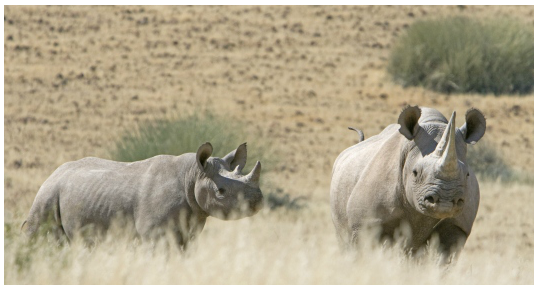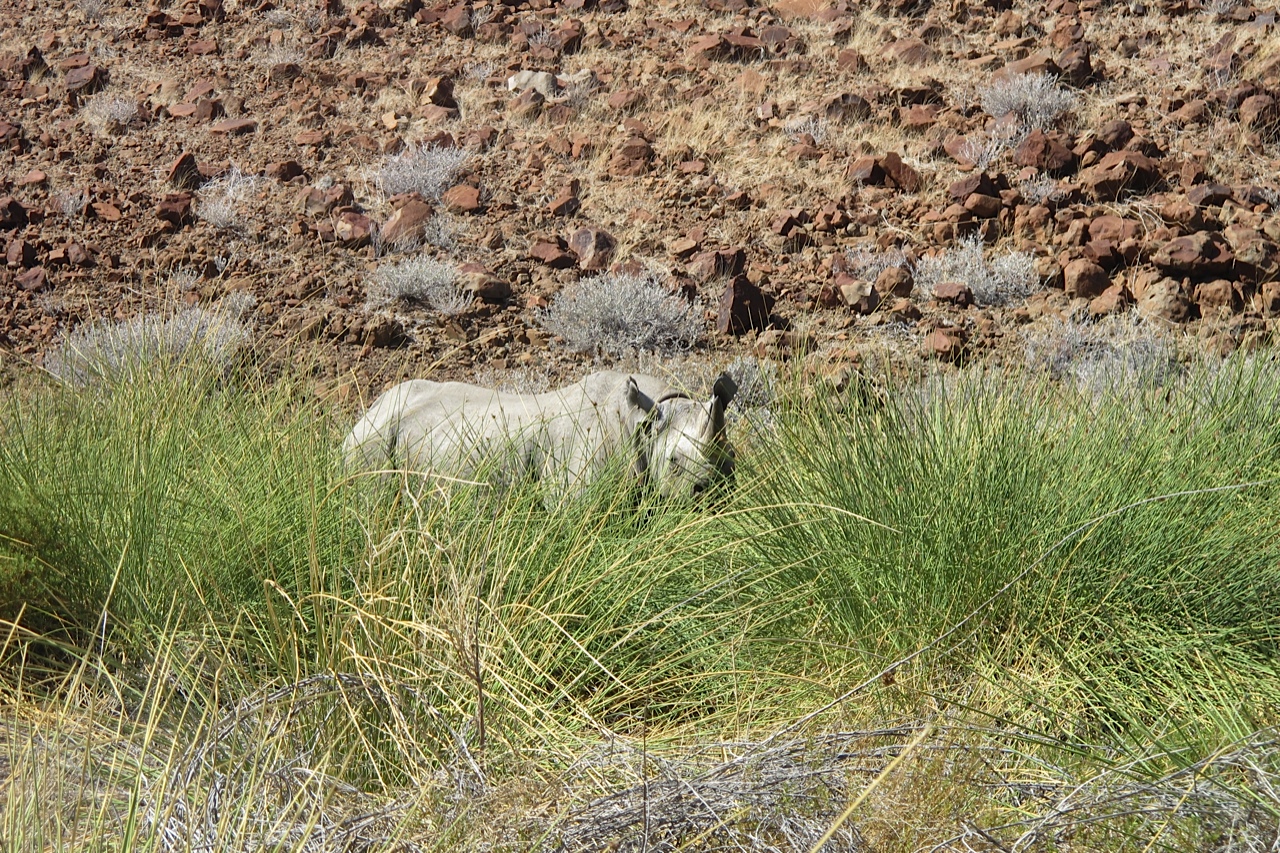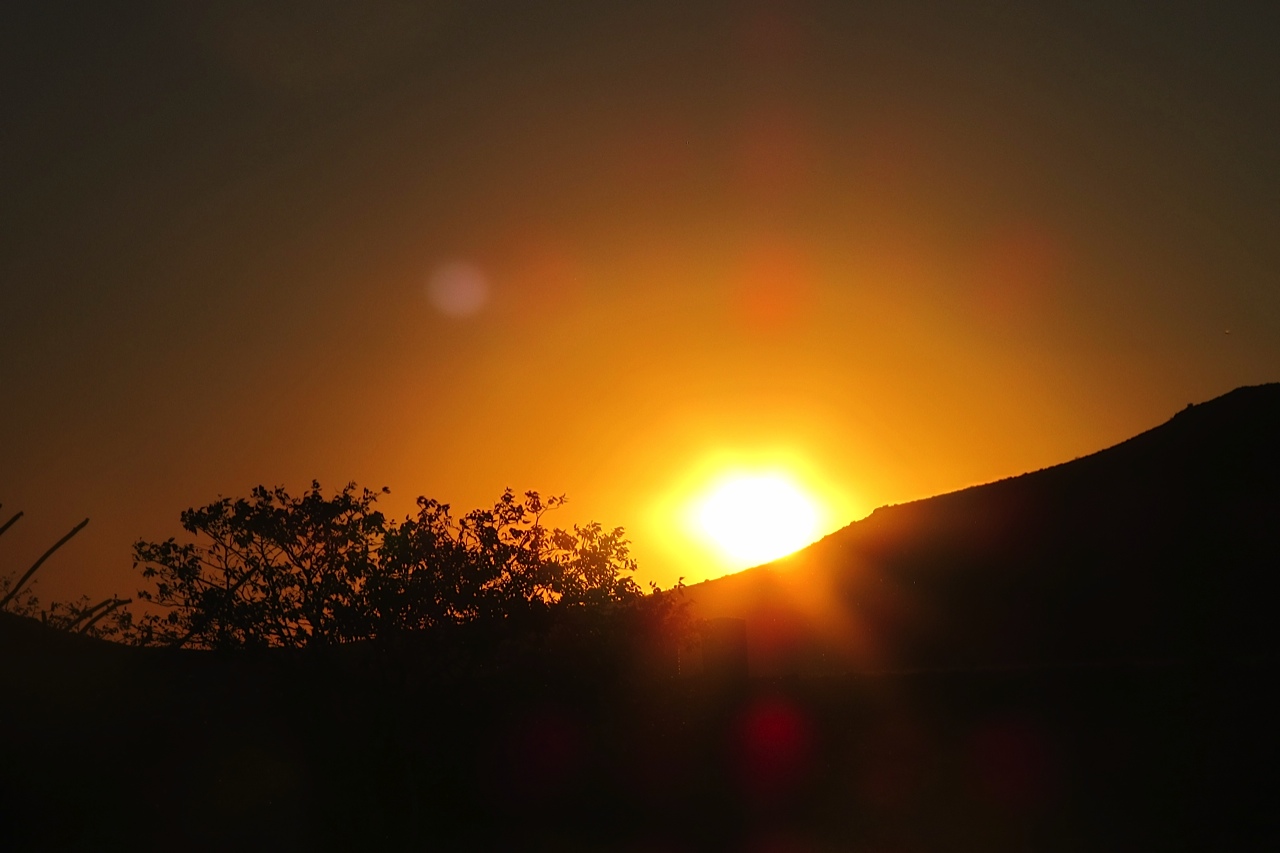I bounce along the rocky track running under Damaraland's cerulean sky with my guide, Raymond, but we don't look up. We scan the space ahead of us bulky shapes. This area is home to one of Africa's last populations of Black Rhinoceros.
My fascination with rhinos goes back to high school, where I read Ionesco's Rhinoceros, a play about the absurdity of human nature. A few years later, I stood in front of Albrecht Dürer's woodcut of a rhinoceros at the British Museum, hypnotized by the prehistoric-looking animal with its two large horns and armor-like hide.
Raymond and I are following the trackers from Save the Rhino Trust who, if they spot a rhino, will record its size, horns, ear notches and tail shape. Raymond has warned me that this is not a zoo and the rhinos are not wearing transmitter collars, so there's no guarantee we'll see one; but if we do, the trackers will signal for us to get out of our vehicle as quietly as possible, walk single file to where they direct us, and remain perfectly still.
Always on the lookout, I scan the ochre mountains and golden hills, dotted with acacias and low shrubs, hoping a rhino will materialize. A Steenbok, one of the smaller antelopes bounces around nearby, flying nearly eight feet in the air with every stride.
"He's showing off," Raymond laughs.
"Is a rhino as skittish as a steenbok?" I ask.
"Rhinos are highly strung," says Raymond. "The minute we enter into his territory he'll be alert, so we must be very careful and do exactly what the Save the Rhino trackers tell us to do."

Endangered Black Rhino, Namibia (Photo courtesy of: Wilderness Safaris)
In the early 1980s, the rhino had been so savagely slaughtered that it was nearly extinct. One morning, a South African botanist, Blythe Loutit, was driving along the road of what was then called Southwest Africa (now Namibia) and saw poached dead rhino carcasses. She was so upset that she established the Save the Rhino Trust in 1982. To find trackers, she went to the jails where the local poachers were incarcerated and persuaded them that there would be a much better benefit if they would conserve the rhino rather than kill it. For the last thirty years, former local poachers have become conservationists and since the 1980s, the numbers of rhino in Namibia have greatly increased.
The trackers in the vehicle ahead of us, one who has been tracking here for 30 years, know 17 rhinos by name. But where are they all, I wonder. Two hours have already passed, but I'd been warned this could take a while.
Five oryx, their horns almost as long as boom handles, run in the distance, stop to look at us, and then run away again until finally, they disappear down an embankment. A pair of Ostrichse peck at the ground, the female bigger than the male.
Another hour passes. "I don't think we're going to see one," I say.
"This is Africa," Raymond says, "Things take time. And besides, a rhino lives 40 to 45 years, so three hours is nothing."
Suddenly the trackers stop and signal for us get out of car. We walk silently until they tell us to stop. Raymond is looking through his binoculars at something about 100 yards away.
"You see the rhino?" he whispers.

Verity, 40-year old rhino at Desert Rhino Camp (Photo courtesy of:Margie Goldsmith)
I look through my binoculars: Next to a bush is a gigantic four-legged animal with large hooved feet, slitty little eyes and two curved horns. Is this real? One of the trackers whispers to me that this is a young bull, probably 7 or 8 years old, weighing in at roughly 1,800 pounds. I am hypnotized for at least fifteen minutes as the rhino chews on the bush, unaware of us.
Finally, the rhino lies down to sleep. His day looks less exciting than mine.
When we pull up to a shade canopy of acacia trees for lunch, the trackers tell me how lucky I am to have seen this rhino. They show me their data book where they have recorded the shape, size, horns, ear notches and tail size of the 17 rhinos in the concession. Each has a name. But none of the trackers has ever seen this particular rhino before. They tell me he must have wondered in from another concession, Then record his data in the book.
We head back towards camp. I am dozing off when we stop abruptly. The trackers have found a second rhino, 40-year-old Verity, who has mothered eight calves. "This is a rare occurrence," Raymond whispers. "We don't often see two different rhinos in one day."

Sunset in Namibia (Photo courtesy of: Margie Goldsmith)
It's a good three hour drive before we'll arrive back in camp, but I don't care because I've seen two rhinos. I breathe in the aroma of wild sage.
